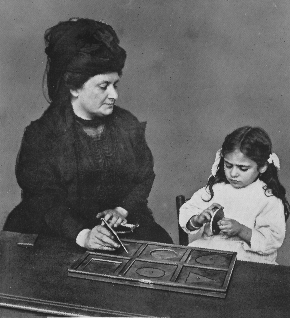Get Re-inspired with the Geometry Cabinet!

As Montessori
practitioners, we each have our favorite materials to present to the
children. And likewise, there always
seems to be a material that we lose our enthusiasm for. For me, this was the Geometry Cabinet. As I began to really reflect on why this
might be, I came to understand that I really didn’t fully appreciate how
dynamic this material is! I would like
to take you on a journey with me to rediscover the Geometry Cabinet.
Let’s start with a
fast refresher on the purposes of this material. The first two are the most obvious, exposure
to and seeing the differences of the plane
geometric shapes. Next, we remind ourselves that the child must have concrete
experiences with their hands to internalize information. So we trace the shape insets and then the
aperture over and over developing muscle memory of the form (which is another
purpose of the material). This action
involves the eye, the hand, and the muscles.
The child comes to a deeper understanding of the nature of the shape by
doing this. Dr. Montessori wrote in the Discovery of the Child (1972, p, 133), “There can be no doubt than an association
of the kinesthetic with the visual sense is of great assistance in the
perception of shapes and in the fixing of them in the memory.” The tracing of the insets has another
important function of indirectly preparing the child for writing. They engage a three-fingered grip as he grasps
the knob of the shape, uses the firmness of touch needed to use a writing
implement, and practices controlling his hand and muscles to follow the
contours of a shape. The purposes address why we offer this
material to the child, but there is more than they receive by interacting with
it.
The geometry
cabinet offers the child the keys to the geometric properties of the world that
surrounds him. “The majority of objects in the external world that confront our eyes
are comparable to our plane insets” (Montessori, Discovery of the Child,1972,
p. 166). As they become familiar with the shapes, we see the child start to
observe them in their environment. This
material can forever change how the child sees the world around them! No longer is a building seen as just a
structure, but a cacophony of geometry!
The child sees the rectangles, squares, and triangles that unite to
create the structure before them. Dr.
Montessori shared that when the child has the knowledge of the insets that they have the information to interpret his surroundings and that “he feels he knows the secrets to the world”
(Discovery of the Child, 1972).
Moving
further, let’s reflect on the child’s future learning that relies on the
knowledge gleaned from this material.
The first that comes to mind is
the constructive triangles. The child
cannot intelligently work with those five boxes without the concrete experience
with the triangles in the cabinet and knowing their names. I have found that many adults may not feel
confident with the names of the seven triangles in the Geometry Cabinet. Revisiting that vocabulary may rekindle some
interest for yourself in the material.
The child will also draw on their experience from the cabinet with the
graded geometric figures and the decanomial square. They will even see these forms in language as they work with the function of words. Moreover, these shapes are woven into the
very nature of the mathematics materials.
Something
that is unique to this material is that multiple students may be working with
the Geometry Cabinet at once and in several different ways! This is an apparatus that can be out all day
long serving multiple children. I feel
that I got “stuck” with this material because I wasn’t utilizing it to its fullest
potential. I had children tracing,
learning the names of the shapes, and inconsistently using the cards. Once I refreshed myself on all of the
presentations, I was able to open up a new world of experiences for the
children. The younger child should be
encouraged to experience a single drawer beyond name lessons. Why not turn this into a memory game by
placing the insets at a distance and the drawer on a rug? Could we offer a blindfold to lend a
stereognostic aspect to the work? How
about facilitating a “bring me” game with the shapes from a distance? Absolutely!
These activities can be done also with two, three, and more drawers at the same
time. Utilizing these exercises keeps
the child returning to the cabinet with excitement!
The card material is
specifically for the child who has left those sensitive periods behind. They have experienced the shapes concretely and
is able to begin abstracting their knowledge of them. Working with three series individually at
first, the solid, thick line, and thin line cards mixed at a distance and then
matched to an inset, will take time to work through, but feels like a game to
the child. Especially when paired with
the guide’s enthusiasm for the work. When
we observe the child’s interest fading, could they be telling us that they need more challenge? The final following
exercise of “Which One is Missing?” may be just what he needs to reconnect with
the material. For this exercise, all of
the series of cards are mixed on the rug.
Without the child looking, the guide removes a single card and sets it
aside. The child will then have to
figure out a way to determine which one was removed. This game offers an incredible amount of
critical thinking, organization, and problem-solving!
There
you have it! We have revisited the purposes and the importance of the Geometry
Cabinet. We looked at the lessons that
are often forgotten that can rekindle your own and the child’s interest in the
material. My hope is that you feel refreshed and ready to offer some new
experiences to your students with the Geometry Cabinet!
Comments
Post a Comment